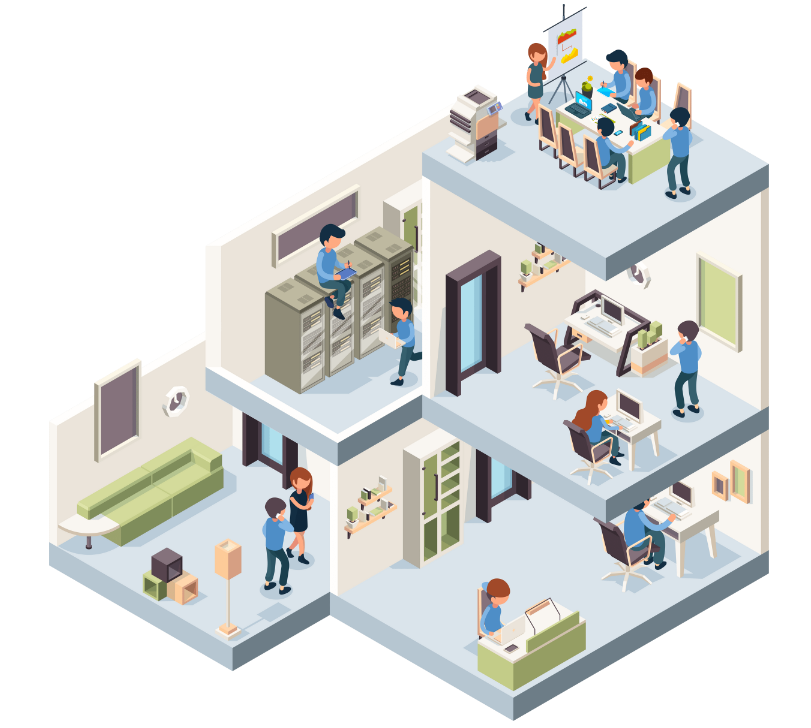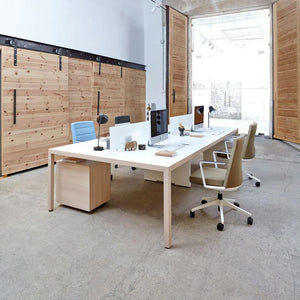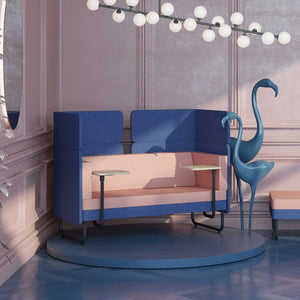
Office Design Trends 2024
We're now 4 years on from the initial COVID-19 lockdowns and 2024 is set to bring exciting new developments in office design. As workplaces continue to evolve and adapt to the needs of modern businesses, it is crucial to stay up-to-date with the latest trends. In this article, we will explore four key office design trends that are predicted to shape the work environments of the future.
Collaborative Spaces and Team Dynamics
One of the most significant trends in office design is the emphasis on creating collaborative spaces that foster teamwork and enhance productivity. In 2024, companies are increasingly recognising the importance of collaboration and are investing in areas designed specifically for group work. These collaborative spaces are equipped with comfortable furniture and technology that allows for seamless collaboration, such as interactive screens and video conferencing facilities.
Office layouts are being reimagined to encourage spontaneous interactions and create opportunities for colleagues to connect and share ideas. Open-plan work areas, breakout zones, and communal spaces are becoming more prevalent, enabling employees to engage in impromptu discussions and brainstorming sessions. Such spaces not only facilitate collaboration but also contribute to a vibrant and dynamic company culture.
Moreover, the design of collaborative spaces is not just about functionality but also about aesthetics. Companies are investing in interior designers to create visually appealing environments that inspire creativity and innovation. Colour schemes, lighting, and furniture choices are carefully curated to evoke a sense of energy and collaboration, making the office an inviting and stimulating place to work in.
In addition, the incorporation of biophilic elements in collaborative spaces is gaining popularity. Biophilic design principles involve bringing nature into the workspace through the use of plants, natural materials, and ample natural light. Research has shown that exposure to nature in the workplace can reduce stress, increase productivity, and enhance overall well-being, making it a valuable addition to collaborative areas.

Maximising Space Efficiency
In an era where building costs are soaring, optimising space efficiency has become a top priority for businesses. Companies are looking for innovative ways to make the most of their office environments, ensuring that every square foot is put to good use. One popular solution is the adoption of flexible workstations or hot desks.
Flexible workstations allow employees to choose their seating arrangements based on their needs, whether it's a traditional desk setup, a standing desk, or a cosy nook for quiet focused work. This flexibility not only reduces the need for excessive office space but also accommodates diverse work styles and preferences.
Additionally, smart storage solutions are gaining traction in 2024. From vertical shelving units to under-desk storage compartments, these space-saving solutions help keep the office clutter-free and organised. Efficient space utilisation not only saves costs but also contributes to a more productive and comfortable work environment.
Moreover, in the quest for space efficiency, businesses are increasingly turning to multifunctional furniture. Pieces like foldable desks that can double as meeting tables or storage ottomans that also serve as seating options are becoming popular choices. These versatile furniture items not only save space but also add a touch of adaptability to the office layout.
Balancing Privacy and Openness in Office Layouts

Creating a harmonious balance between privacy and openness in office layouts remains a key consideration for businesses in 2024. While collaborative spaces are essential for fostering teamwork, employees also require private areas for focused work and confidential discussions.
To strike the right balance, office designers are incorporating flexible partition systems that allow for easy customisation of workspace configurations. These partitions can be soundproof and be quickly moved or rearranged to align with changing privacy needs. Moreover, the growing popularity of phone booths, meeting booths and quiet rooms offers employees dedicated spaces where they can concentrate without interruptions.
When considering the layout of an office space, it's crucial to take into account the diverse needs and preferences of employees. Some individuals thrive in open, collaborative environments where ideas flow freely, while others require quiet, secluded areas to focus and be productive. By offering a variety of workspace options, businesses can cater to the different work styles present within their workforce.
Additionally, the use of innovative technology plays a significant role in balancing privacy and openness in modern office layouts. Smart sensors can monitor occupancy levels and noise levels, providing valuable data to inform decisions about space utilization and design modifications. This data-driven approach enables businesses to create dynamic work environments that adapt to the evolving needs of their employees.
Technology Integration for Modern Offices
In the ever-evolving world of technology, it comes as no surprise that office design in 2024 is heavily influenced by technological advancements. From smart devices to AI-powered systems, integrating technology seamlessly into the workspace is crucial for maximizing efficiency and productivity.
One notable trend is the integration of Internet of Things (IoT) technology into office design. This allows various office systems, such as lighting, temperature control, and security, to be interconnected and controlled remotely. IoT not only enhances the overall user experience but also enables companies to monitor and optimise resource usage, ultimately leading to cost savings.

Besides IoT, virtual reality (VR) and augmented reality (AR) technologies are making their way into the workplace, particularly for training and collaborative purposes. VR and AR can simulate real-world scenarios and enable remote collaboration, saving time and travel costs while providing a more immersive and engaging experience.
Moreover, the concept of activity-based working (ABW) has gained popularity in modern offices. ABW allows employees to choose from a variety of work settings based on the nature of their tasks, promoting flexibility and collaboration. By providing diverse workspaces such as quiet zones, collaboration areas, and standing desks, companies can cater to the different needs and preferences of their workforce.
In conclusion, the office design landscape of 2024 is characterised by collaborative spaces, efficient use of space, a balance between privacy and openness, the integration of cutting-edge technology, biophilic design elements, and activity-based working principles. Companies that embrace these trends will not only create workspaces that attract and retain top talent but also foster innovation and drive business success.


